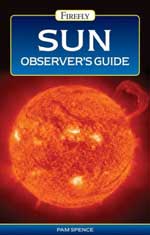
Our sun produces vast amounts of energy through nuclear reactions. Due to this energy and the sun’s huge mass, the sun consists mostly of sub atomic particles and ionized atoms especially hydrogen and helium. These rocket and careen within the sun and then via convection and radiation they work their way out through the surface, the photosphere, and onward throughout the solar system. The photosphere, tenuous as it is, can be seen to resemble porridge with a fairly homogeneous mix of small light and dark patches. Occasionally, a large dark spot occurs. Seemingly harmless, this spot is quite often a burst of energy and matter that sends an energetic stream of particles and radiation out from the sun. Perhaps harmless in appearance these spots can disrupt radio traffic, fail electrical power grids and knock out satellites. But on the good side, these spots are the main subjects for sun observers.
Using sun spots, observers can assign a latitude and longitude coordinate system to the sun. They can define the sun’s rotation rate and its ‘mood’. A sullen sun may have only one or even no sunspots on its surface. At other times, the playful sun could have hundreds of sunspots. This activity cycles through its minimum and maximum over an eleven year period. However the sun can quiet down for a longer time. Between 1645 and 1715 there was almost no sun spot activity. We refer to this time as a little ice age here on Earth due to the much cooler temperatures experienced. Of course, the opposite can happen. Unusually high sun spot activity occurred in the years 1000 to 1250 and a warmer climate allowed Vikings to settle in Greenland. So, not only are sun spots the main characteristic of our sun, they also have a direct influence on the earth’s climate. There can’t be a much better reason for observers to continue their studies!
One of the main benefits of observing the sun is that minimal equipment is required. Some observations are achievable with binoculars and a few sheets of paper. A small refractor telescope is better than binoculars, but due to the sun’s energy, small is actually better than large. And using paper with appropriate grids and scales on it aids in locating and sizing sun spots that do appear. Then, using the techniques described in this book, a viewer can characterize and record their observations in a manner that is useful for their own benefit and in a manner that would be advantageous to professional bodies, if the observer wanted to share their work. This isn’t that far fetched, as the author herself contributes as an amateur and then works with an organization that makes use of amateur observations.
Aside from sun spots, the other great viewing attraction of the sun is its eclipse. Because of its rarity and its spectacular sight, the eclipse draws people from everywhere in the world. If you are fortunate enough to be on a path of totality, you will see the sun go through a number of distinct phases. It starts with an annular eclipse, where the moon moves to block the sun’s light. When the moon almost exactly covers the sun only some of the photosphere is visible at the moon’s edges and the moon appears to have a ring of fire about its circumference. Should a valley on the moon allow a ray of light to sparkle and flash in the sun’s normal white colour with the beads somewhat like a diamond ring. At totality the photosphere is completely blocked and the ghostly corona shimmers and shines in vibrant ribbons floating around the ring of the moon. Then these phases repeat themselves in reverse order, as the moon continues in its orbit past the sun. The solar eclipse is truly worth travelling to see.
To learn a bit about the sun and of the pleasures in viewing it then Pam Spence’s book, Sun Observer’s Guide, is a handy reference. Sometimes it can be repetitive in its instructions and there is very little on why the sun does what it does. However, there is more than sufficient detail on how to look, what to look for and what the value is of the observations. The unaided and unknowing eye may consider the sun a rock steady source of light and heat, but an educated viewer, with the help of this book, will know better.
To read more reviews, or order the book online, visit Amazon.com.
Review by Mark Mortimer
